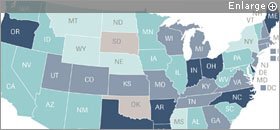It’s all about the people. That’s the message that data evangelists are sending to K-12 educators and policymakers.
Now that the technological foundation for the use of robust systems of longitudinal education data has been laid in most states and school districts, experts say the focus needs to turn to making such data more useful for teachers, administrators, parents, and students, That will require a mix of strong leadership at the state and districts levels, greater collaboration across state agencies, and much better professional development and ongoing support for teachers and administrators.
“We make a really big deal out of trying to make sure that that information is useful and presented in a way that people can understand,” said Charles McGrew, the executive director of the P-20 Data Collaborative in Kentucky, a state that has made significant progress in recent years in using data to improve education.
The shift in priorities from putting hardware and software in place to figuring out how data are used by actual people is a theme highlighted in a released by the . The Washington-based nonprofit group aims to help schools use data such as graduation rates, standardized-test scores, and attendance to improve student achievement. Encouraging state education departments to make such data more relevant and useful by linking it to other state agencies is a key component of the organization’s mission. So is advocating for robust professional development for educators to better understand education data.
“When you look at the actions that are lagging, it’s because those are the ones that require the focus on people,” said Aimee Guidera, the executive director of the Data Quality Campaign. The infrastructure of data systems has largely been built, she said, but now, “it’s not just about collecting the data, but putting a focus on how we make sure that valuable, actionable, contextual information gets into the hands of stakeholders.”
The Data Quality Campaign is tracking the number of actions states are taking to improve the use of data in education.

SOURCE: Data Quality Campaign
In the report, states are evaluated on the basis of 10 actions they are encouraged to take to support effective data use. Those actions fall into three categories: linking data and making sure that the infrastructure and policies are in place to maintain those linkages; making sure that data can be accessed, analyzed, and used; and ensuring that stakeholders have access to the information and know how to use it.
The report says states are lagging in actions to link education data with workforce data, ensure appropriate stakeholders have access to data, provide data-literacy training and professional development for educators, and share K-12 education data with local teacher-preparation programs.
Leading States
While no states have taken all the recommended actions, 10 states now have eight or nine in place, up from four states in 2011.
Kentucky has taken six of the 10 actions defined by the Data Quality Campaign, four more than last year. (“Data Driving College Preparation,” Nov. 16, 2011.)
Part of its success can be attributed to leadership that has taken a history of valuing education data, said Mr. McGrew, especially in the state legislature, which has protected the $600,000 in annual funding for building data systems despite holes in the state budget. (The state faced about $360 million in spending cuts in the first year of the 2012-14 biennial budget, on top of cuts that shaved more than 25 percent off the budgets of most state agencies in previous years.) In addition, in 2009, the legislature passed a measure requiring the state to collect, share, and report data to improve postsecondary enrollment and decrease remediation.
As a result, the state has taken a hard look at its high school feedback reports, which provide information about how well students do in postsecondary education after graduating from high school. Thanks in part to the work of the P-20 Data Collaborative, as well as focus groups held by education leaders in the state with K-12 teachers to determine how to make the feedback reports more helpful, the state has seen postsecondary enrollment grow from 50.9 percent in 2004 to 61.4 percent in 2010.
Although that rise cannot be solely credited to the emphasis on better data use, both state and national experts say, having those measures in place certainly helped boost those numbers.
Another state that has made great strides in using data is Oregon, which has completed eight of the 10 actions recommended by the Data Quality Campaign. Leadership in the governor’s office was also credited for putting data use high on the priority list.
For instance, the creation by Gov. John Kitzhaber, a Democrat, of the Oregon Education Investment Board in 2011, which pulls together educators and community leaders to create a unified P-20 education system, was instrumental in supporting a robust data system in the state, said Doug Kosty, the assistant superintendent in the office of assessment and information services for the state department of education.
“That was really the push we needed to get where we’re at,” he said. Because of the education investment board, the state has now started collecting and sharing pre-K data from publicly funded programs and has made strides in incorporating workforce data into the system, he said.
In addition, Oregon has focused on forming sustainable professional-development communities to teach educators what the data mean and how to use the information, he said.




